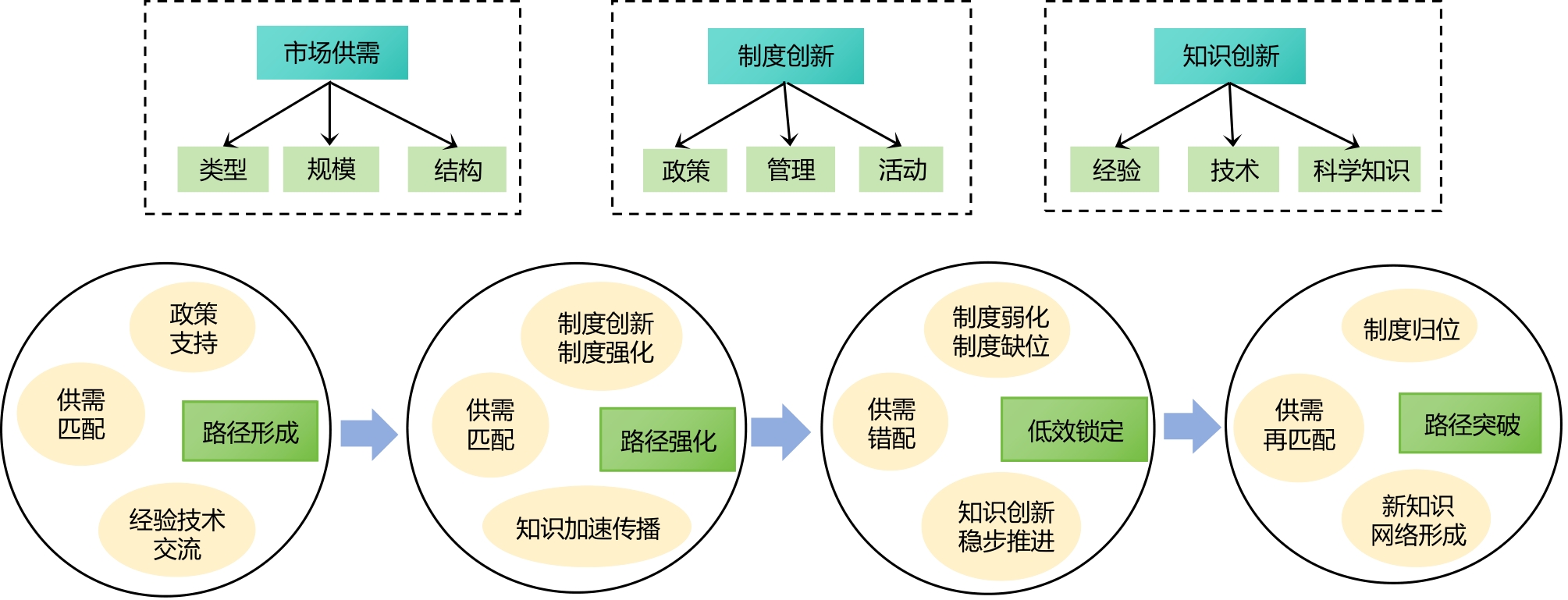

路径依赖、锁定与突破:农业产业集群的演化路径与演化机制探究——以江苏省扬州市江都区花木产业集群为例
|
徐菊芬(1982—),女,江苏苏州人,博士研究生,主要研究方向为城镇化与城乡发展机制,(E-mail)58551112@qq.com。 |
收稿日期: 2024-01-29
修回日期: 2024-04-27
网络出版日期: 2024-12-11
基金资助
国家自然科学基金面上项目“移动互联网时代城乡接合部空间重构的特征、机制与规划应对研究”(52378059)
江苏省自然资源科技计划项目“乡村振兴背景下特色产业集群发展路径研究——以扬州市江都区花木产业集群为例”(2021012)
Path Dependence, Lock-in, and Breakthrough: An Exploration of the Evolutionary Path and Evolutionary Mechanisms of Agricultural Industry Clusters: A Case Study of the Flower and Plant Industry Cluster of Jiangdu District in Yangzhou City, Jiangsu Province
Received date: 2024-01-29
Revised date: 2024-04-27
Online published: 2024-12-11
农业产业集群具有技术关联度偏低、政策依赖度较高的特征,在演化发展过程中更容易因路径依赖而陷入低效锁定。为探究其演化路径与机制,文章基于演化经济地理学的视角,结合实地调研与半结构访谈法,以扬州市江都区花木产业为例展开实证研究,剖析农业产业集群的路径形成、路径锁定与路径突破,总结产业集群动态演化的作用机制,结果表明:1)市场需求是农业产业集群演化的重要动力,产业集群的演化过程可以看作是在“市场供需匹配”基本原则下做出的“需求反馈―供给调整―需求再反馈”的循环过程;2)制度支持是农业产业集群演化的基本保障,新路径的创建过程需要创新制度的供给加以呵护,旧路径的调整也需要相应的政策来引导低效产业的退出和种植结构的转型;3)知识创新是农业产业集群演化的关键推力,无论是基于地缘关系的经验交流,还是更具创新水平的科学知识和专业技术的传播,以及移动互联网时代更加多元的知识网络构建,都极大地推动了产业集群的自我强化发展。

徐菊芬 , 杨雅涵 . 路径依赖、锁定与突破:农业产业集群的演化路径与演化机制探究——以江苏省扬州市江都区花木产业集群为例[J]. 热带地理, 2024 , 44(12) : 2214 -2223 . DOI: 10.13284/j.cnki.rddl.20240058
Owing to their low technological relevance and high dependence on policies, agricultural industry clusters are more likely to fall into inefficient locking-ins in the process of evolutionary development. Based on the perspective of evolutionary economic geography, this study analyzes the formation of path dependence and the locking-in and breakthrough of agricultural industrial clusters, and summarizes the main characteristics of industrial clusters in the dynamic evolution process. First, the study examines the three major elements of market, technology and institution, and presents an evolutionary analysis framework of agricultural industrial clusters from path selection, path reinforcement to path locking and path breakthrough. Second, it combines field research and semi-structured interviews to conduct qualitative research on the flower and plant industries in Jiangdu District, Yangzhou City. The evolution of this industry could be divided into four stages: industrial agglomeration in the initial period, cluster development in the expansion period, inefficient locking in the bottleneck period, and the creation of new paths in the transition period. Third, the research analyzes the evolutionary mechanisms of agricultural clusters. The results show that market demand is the fundamental driving force for the evolution of agricultural clusters, and the process could be regarded as a cycle of "demand feedback-supply adjustment-demand re-feedback" based on the basic principle of "market supply and demand matching." Furthermore, institutional support is a basic guarantee of the evolution of agricultural clusters. The creation of a new path requires innovative institutional supply, while adjusting the old path requires an appropriate policy to guide the exit of inefficient industries. Additionally, knowledge innovation is the key driving force for the evolution of agricultural clusters, including the exchange of experience based on geographical ties, the exchange of scientific knowledge and technology with greater professional depth, and the construction of more diversified knowledge networks in the mobile-Internet era. They contributed significantly to the self-reinforcement of industrial clusters. Above all, it is identified that the life cycle of the industry cluster theory continues to have explanatory power for the evolution process and mechanism of agricultural industry clusters. The three interrelated elements of market demand, institutional support, and knowledge innovation promote cluster evolution. When it meets market demand and exhibits growth, support measures such as space guarantees, infrastructure, communication activities, and industry organization tend to follow the trend, and the cluster is pushed forward to deeper levels of the industrial chain and knowledge network. When there is a structural mismatch between market supply and demand, limited resources (including land, capital, policy, and manpower) may be gradually withdrawn and turned to industries with greater growth potential. If there are no new growth opportunities or market demands, industrial clusters are likely to enter the trap of inefficient development or even disintegration. When the new format of the industry meets market demand again, industrial metamorphosis will occur in the new knowledge network, which will also lead to a more accurate institutional supply and a breakthrough from the old path.

表1 江都区花木产业集群的演化历程Table 1 The evolution of flower and plant industry cluster in Jiangdu District |
| 要素 | 1985—2000年 | 2000—2016年 | 2017年以来 | 2014年以来 |
|---|---|---|---|---|
| 路径形成 | 路径强化 | 路径锁定 | 路径突破 | |
| 产业类型 | 花木种植 | 花木、园林绿化工程、盆景 | 花木、绿化工程及养护 | 造型苗木、花木盆景 |
| 产业主体及 集聚形式 | 专业村(农户)、林园场、花木企业 | 大中型企业、科研机构、苗木 承包大户;专业市场、产业园 | 大中型企业、苗木承包大户、 科研机构;专业市场 | 大型企业、个人盆景工作室、 专业村;专业市场 |
| 结网特征 | 基于地缘关系的地方生产网络 | 国内生产网络 | 国内生产网络 | 国内生产网络为主,开始融入 全球生产网络 |
| 服务市场 | 江苏省内、政府采购为主 | 全国范围内、地产项目为主 | 项目收缩、周边地区为主 | 全国乃至全球范围,个人、家庭消费为主 |
| 制度支持 | 政府投资国有苗圃并直接采购 | 政府举办花卉节,建设花木产业园、花木大道,成立花木协会、盆景协会 | 停办花卉节、虚置花木协会 | 选拔、任用花木乡土人才,举办盆景艺术节 |
| 知识创新 | 种植经验交流 | 科学知识快速交流、传播、应用 | 知识创新稳步发展 | 扬派盆景技艺创新、移动互联网技术应用 |
“我在网上不仅卖盆景,也提供养护服务,在我的直播间我都会跟粉丝讲解怎么修剪,怎么养护……我的作品在瘦西湖景区的盆景博物馆多次展出……目前的经营状况很好,我的粉丝遍布全国,互联网帮助我在全国(范围)寻找消费者,我很看好花卉盆景的前景。”

1 数据来源:扬州市自然资源和规划局江都分区下属江都区林业站提供的相关资料。
2 根据江都区林业站提供的花木企业基础数据、百度POI数据,获取并清洗得到195条花木产业主体(花木企业、种植大户、主要经纪人)的空间坐标,该数据经江都区林业站核准。
3 江都区花木协会原属农业农村局管理,2018 年因部门职能调整而被纳入新成立的自然资源和规划局管理。走访中了解到该协会在新主管单位得到的政策支持非常有限。
徐菊芬:论文框架建构、论文撰写、论文修改;
杨雅涵:资料收集整理、图表制作、论文修改。
特别感谢扬州市自然资源和规划局江都分局的盛长元局长、江都区林业站高红芽站长对本研究提出的宝贵建议!参考文献(References):
|
Arthur W B. 1989. Competing Technologies, Increasing Returns, and Lock-In By Historical Events. Economic Journal, 99 (3): 116-131.
|
|
Arthur W B. 1994. Increasing Returns and Path Dependence in the Economy. Ann Arbor: University of Michigan Press.
|
|
陈嘉,韦素琼,陈松林. 2019. 中国台商农业技术时空扩散的格局、路径与机制——以福建省漳浦县为例. 地理科学,39(6):957-966.
Chen Jia, Wei Suqiong, and Chen Songlin. 2019. Spatial and Temporal Diffusion of Taiwanese Agricultural Technology: A Case Study in Zhangpu County, Fujian Province. Scientia Geographica Sinica, 39(6): 957-966.
|
|
陈嘉,韦素琼,李锋. 2021. “共位集群”视角下的农业产业集群演化路径与网络——以福建省漳平市茶产业为例. 热带地理,41(2):364-373.
Chen Jia, Wei Suqiong, and Li Feng. 2021. The Evolution Path and Network of Agricultural Clusters from the Perspective of "Co-Location Clusters": A Case Study of the Zhangping Tea Industry in Fujian Province. Tropical Geography, 41(2): 364-373.
|
|
David P A. 1985. Clio and the Economics of QWERTY. American Economic Review, 75(2): 332-337.
|
|
David P A. 1994. Why are Institutions the "Carriers of History"? Path Dependence and the Evolution of Conventions, Organizations and Institutions. Structural Change and Economic Dynamics, 5(2): 205-220.
|
|
Frenken K, Van Oort F, and Verburg T. 2007. Related Variety, Unrelated Variety and Regional Economic Growth. Regional Studies, 41(5): 685-697.
|
|
Fornahl D and Hassink R 2017. The Life Circle of Clusters: A Policy Perspective. Cheltenham, UK: Edward Elgar Publishing.
|
|
贺灿飞. 2021. 高级经济地理学. 北京:商务印书馆. [He Canfei. 2021. Advanced Economic Geography. Beijing: Commercial Press.]
|
|
贺灿飞,李伟. 2022. 区域高质量发展:演化经济地理学视角. 区域经济评论,(2):33-42.
He Canfei and Li Wei. 2022. Regional High-quality Development: Perspective from Evolutionary Economic Geography. Regional Economic Review, (2): 33-42.
|
|
李二玲. 2020. 中国农业产业集群演化过程及创新发展机制——以“寿光模式”蔬菜产业集群为例. 地理科学,40(4):617-627.
Li Erling. 2020. The Formation, Evolution and Innovative Development of Agricultural Clusters in China: Case of the Cluster Nature of "Shouguang Mode". Scientia Geographica Sinica, 40(4): 617-627.
|
|
罗震东. 2020. 新兴田园城市:移动互联网时代的城镇化理论重构. 城市规划,44(3):9-16. [Luo Zhendong. 2020. E-Garden City: Reconstruction of Urbanization Theory in the Mobile Internet Era. City Planning Review, 44(3): 9-16.
|
|
Martin R and Sunley P. 2006. Path Dependence and Regional Economic Evolution. Journal of Economic Geography, 4(6): 395-438.
|
|
Menzel M P and Fornahl D. 2009. Cluster Life Cycles-Dimensions and Rationales of Cluster Evolution. Industrial and Corporate Change, 19(1): 205-238.
|
|
梅燕,蒋雨清. 2020. 乡村振兴背景下农村电商产业集聚与区域经济协同发展机制——基于产业集群生命周期理论的多案例研究. 中国农村经济,(6):56-74.
Mei Yan and Jiang Yuqing. 2020. The Mechanism Between Rural E-Commerce Industry Agglomeration and Regional Economic Development in the Context of Rural Revitalization: A Multi-Case Study Based on the Life Cycle Theory of Industrial Clusters. Chinese Rural Economy, (6): 56-74.
|
|
North D C. 1990. Institutions, Institutional Change and Economic Performance. Cambridge: Cambridge University Press.
|
|
Ramirez M, Clarke I, and Klerkx L. 2018. Analysing Intermediary Organisations and Their Influence on Upgrading in Emerging Agricultural Clusters. Environment and Planning A: Economy and Space, 50(6): 1314-1335.
|
|
史焱文,李二玲,李小建,娄帆,陈晓燕. 2015. 基于SNA的农业产业集群创新网络与知识流动分析——以寿光蔬菜产业集群、鄢陵花木产业集群为例. 经济地理,35(8):114-122 .
Shi Yanwen, Li Erling, Li Xiaojian, Lou Fan, and Chen Xiaoyan. 2015. The Agricultural Industry Cluster Innovation Network and Knowledge Flow Based on SNA: The Cases of Shouguang Vegetable Cluster and Yanling Flower and Plant Cluster. Economic Geography, 35(8): 114-122.
|
|
史焱文,李二玲,李小建,任世鑫. 2019. 农业产业集群创新通道及溢出效应——以山东寿光蔬菜产业集群为例. 地理科学进展,38(6):861-871.
Shi Yanwen, Li Erling, Li Xiaojian, and Ren Shixin. 2019. Innovation Pathways and Spillover Effects of Agricultural Industrial Clusters: A Case of Vegetable Production Industrial Cluster in Shouguang City, Shandong Province. Progress in Geography, 38(6): 861-871.
|
|
汤爽爽. 2018. 城乡关系视角下乡村政策的演进:基于中国改革开放40年和法国光辉30年的解读. 现代城市研究,(4):17-22.
Tang Shuangshuang. 2018. The Evolution of Rural Policies from the Perspective of Urban-Rural Relationship: Interpreting Rural Policies During the 40 Years of Reform and Opening-Up in China and 30 Glorious Years in France. Modern Urban Research, (4): 17-22.
|
|
汤爽爽,余景亮,高晨宇,朱婷,马丽. 2021. 江苏先进制造业集群的空间分布特征及发展优劣势分析. 科技中国,(3):69-75.
Tang Shuangshuang, Yu Jingliang, Gao Chenyu, Zhu Ting, and Ma Li. 2021. Spatial Distribution Characteristics and Development Advantages and Disadvantages Analysis of Jiangsu Advanced Manufacturing Clusters. Scitech in China, (3): 69-75.
|
|
胥亚男,李二玲. 2023. 基于行业知识基础的特色农业集群技术创新网络演化——鄢陵花木和烟台葡萄酒产业集群对比研究. 经济地理,43(10):139-147.
Xu Yanan and Li Erling. 2023. Evolution of Technology Innovation Network of Characteristic Agricultural Clusters Based on the Industry Knowledge Base: Comparative Analysis of Yanling Floriculture and Yantai Wine Industry Clusters. Economic Geography, 43(10): 139-147.
|
|
张京祥,黄龙颜. 2022. 城镇化2.0时代的中国新城规划建设转型. 上海城市规划,(2):54-58.
Zhang Jingxiang and Huang Longyan. 2022. Transition of China's New Town Development in the Context of Urbanization 2.0. Shanghai Urban Planning Review, (2): 54-58.
|
|
张云逸,曾刚. 2010. 技术权力影响下的产业集群演化研究——以上海汽车产业集群为例. 人文地理,25(2):120-124.
Zhang Yunyi and Zeng Gang. 2010. Study on Evolution of Industry Clusters with the Influence of Technical Power: A Case Study of Shanghai Automobile Industry Cluster. Human Geography, 25(2): 120-124.
|
/
| 〈 |
|
〉 |